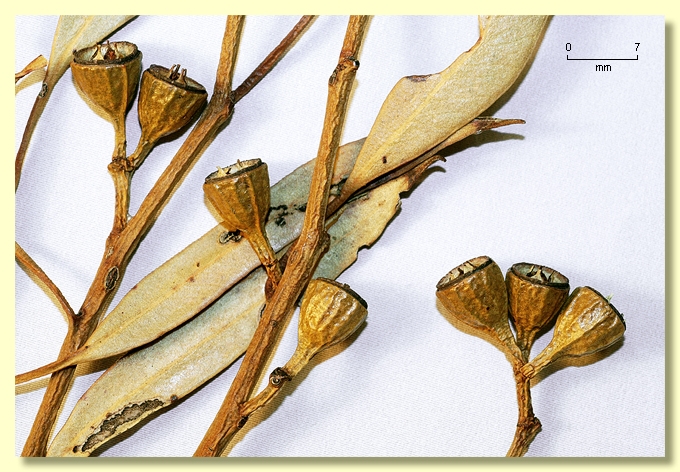Eucalyptus | Symphyomyrtus | Dumaria | Rufispermae
Euclid - Online edition
Eucalyptus distuberosa subsp. distuberosa
Eucalyptus distuberosa D.Nicolle subsp. distuberosa, Nuytsia 19: 85-90 (2009).
T: Western Australia: north-east of Yellowdine on vermin proof fence, 31° 09' 53" S, 119° 50' 19" E, 1 October 2000, D. Nicolle 3480 & M.E. French (holo: PERTH; iso: CANB).
Slender mallet to 14 m tall. Lignotuber absent.
Bark wholly smooth, light grey to grey and brown over orange to yellow, creamy white or light tan; shedding in long ribbons conspicuously hanging from branches to ground level in springtime.
Branchlets have oil glands in the pith.
Juvenile growth (coppice or field seedlings to 50 cm): not seen.
Adult leaves alternate, petiole 1.2–2 cm long; blade narrowly lanceolate or linear, 6.5–10(12) cm long, 0.8–1.5(2.2) cm wide, base tapering to petiole, margin entire, apex pointed, concolorous, very glossy, green, side-veins at an acute or wider angle to midrib, reticulation moderate to dense, intramarginal vein present, oil glands numerous, intersectional and island.
Inflorescence axillary unbranched, peduncles 0.5–1.3 cm long, buds (3)7 per umbel, pedicellate, pedicels 0.2–0.6 cm long. Mature buds obovoid to pyriform (0.6–0.9 cm long, 0.5–0.7 cm wide), radially striate on operculum and with ca 10 weak ribs continuing down hypanthium, outer operculum shed early leaving a scar, inner operculum coarsely beaked to rounded or "turban-shaped", slightly wider than hypanthium at the join when mature, stamens inflexed, anthers oblong to wedge-shaped, versatile, dorsifixed, dehiscing by longitudinal slits, style long and straight, stigma rounded to tapered, locules 4, the placentae each with 4 vertical rows of ovules. Flowers not seen.
Fruit pedicellate, pedicels 0.2–0.7 cm long, cupular to obconical, (0.5)0.6–0.8 cm long, 0.6–0.8 cm wide, shallowly ridged longitudinally, disc descending obliquely, valves 4, near rim level.
Seeds reddish brown and glossy, 1.3–2.1 mm long, flattened-ovoid to slightly angular, dorsal surface sometimes lacunose, smooth to shallowly reticulate, hilum ventral.
Cultivated seedlings (measured at ca node 10): (from Nicolle, 2009) cotyledons reniform; stems square in cross-section, slightly warty; leaves always petiolate, [opposite for few nodes then alternate,] ovate, size not recorded, green to blue-green, slightly glossy.
Flowering has been recorded in October.
Eucalyptus distuberosais a slender mallet endemic to Western Australia where found in the Goldfierlds region from north of Lake Deborah and Yellowdine area extending east to Juardi and Norseman then south as far as Frank Hann National Park. It is a component of woodlands on more or less level sites with stony and sandy loam soils or clay loam, or on slight rises on sand over clay loam. Eucalyptus distuberosa is a smooth-barked glossy leaved mallet species with no visible white waxiness, and small ribbed buds and fruit.
Eucalyptus distuberosa was described in 2009 and in the classification of Brooker (2000) would belong in Eucalyptus subgenus Symphyomyrtus section Dumaria having these features: buds initially with two opercula the outer shed early, stamens strongly inflexed, ovules in 4 rows on the placentae and cotyledons reniform. Within section Dumaria the species belongs to a large sub-group of closely related species (series Rufispermae, 37 described species and subspecies) diagnosed by glandular pith in the branchlets, cuboid-wedge shaped versatile anthers, and by the reddish brown and glossy, flattish seeds which are unique to the series.
The non-lignotuberous tree (mallet) E. distuberosa was once included under the name E. pileata , this being a mallee (lignotuberous plant) with a wide distribution in the mallee zone south of the Goldfields, from Ravensthorpe to Salmon Gums. The lack of dormant vegetative buds in the form of a lignotuber, seed-only means of regeneration after crown-loss, tree habit and occurrence in a slightly drier habitat on flatter sites are the differences that separate E. distuberosa from E. pileata—bark, leaves, buds, fruit and seeds are virtually identical.
In its natural geographic range E. distuberosa occurs with many other mallet species but can be easily distinguished by the combination of smooth bark, pith glands present, glossy green narrow adult leaves, no white waxiness, buds with radially striate opercula slightly wider than the hypanthium and pedicellate fruit ca 0.6-0.8 cm wide. The closely related mallet E. spreta occurs further east and south-east and characteristically branches low on the trunk and has slightly smaller buds with ribbing confined to the conical operculum, and similarly small though unribbed fruit. The closely related Goldfields mallet E. polita has sessile, essentially smooth buds and fruit and tall slender graceful high-branching trunks.
There are two subspecies:
E. distuberosa subsp. distuberosa
Occurs from north of Lake Deborah and Yellowdine area extending east to Juardi and Woolgangie and then south-east to near Mount Day east to Norseman and south about as far as Frank Hann National Park. It differs from subsp. aerata only in the less-pronounced (but still obvious) ribbing on the buds and fruit.
E. distuberosa subsp. aerata
Has a restricted occurrence at Bronzite Ridge between Lake Johnston and Norseman, within the geographic range of subsp. distuberosa. It is distinguished by pronounced ribbing on buds and fruit, ribs ca 1 mm deep, and more conical operculum. It occurs or slight rises with red loamy soils or clay, with some ironstone gravel.
Eucalyptus distuberosa subsp. distuberosa: from Latin dis meaning not, and tuber meaning bump or swelling, referring to the lack of a lignotuber in this species.








